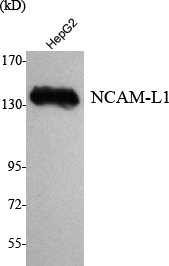NCAM-L1 Monoclonal Antibody
- 货号:YM1063
- 应用:WB
- 种属:Human;Mouse;Rat;Dog;Rabbit
- 简介:
- >>Axon guidance;>>Cell adhesion molecules
- 蛋白名称:
- Neural cell adhesion molecule L1
- 免疫原:
- Purified recombinant human NCAM-L1 (N-terminus) protein fragments expressed in E.coli.
- 特异性:
- NCAM-L1 Monoclonal Antibody detects endogenous levels of NCAM-L1 protein.
- 组成:
- Liquid in PBS containing 50% glycerol, 0.5% BSA and 0.02% sodium azide.
- 稀释:
- WB 1:1000 - 1:2000. Not yet tested in other applications.
- 纯化工艺:
- Affinity purification
- 储存:
- -15°C to -25°C/1 year(Do not lower than -25°C)
- 其他名称:
- L1CAM;CAML1;MIC5;Neural cell adhesion molecule L1;N-CAM-L1;NCAM-L1;CD antigen CD171
- 背景:
- The protein encoded by this gene is an axonal glycoprotein belonging to the immunoglobulin supergene family. The ectodomain, consisting of several immunoglobulin-like domains and fibronectin-like repeats (type III), is linked via a single transmembrane sequence to a conserved cytoplasmic domain. This cell adhesion molecule plays an important role in nervous system development, including neuronal migration and differentiation. Mutations in the gene cause X-linked neurological syndromes known as CRASH (corpus callosum hypoplasia, retardation, aphasia, spastic paraplegia and hydrocephalus). Alternative splicing of this gene results in multiple transcript variants, some of which include an alternate exon that is considered to be specific to neurons. [provided by RefSeq, May 2013],
- 功能:
- disease:Defects in L1CAM are a cause of partial agenesis of the corpus callosum [MIM:304100]; a X-linked disorder.,disease:Defects in L1CAM are the cause of hydrocephalus due to stenosis of the aqueduct of Sylvius (HSAS) [MIM:307000]. Hydrocephalus is a condition in which abnormal accumulation of cerebrospinal fluid in the brain causes increased intracranial pressure inside the skull. This is usually due to blockage of cerebrospinal fluid outflow in the brain ventricles or in the subarachnoid space at the base of the brain. In children is typically characterized by enlargement of the head, prominence of the forehead, brain atrophy, mental deterioration, and convulsions. In adults the syndrome includes incontinence, imbalance, and dementia. HSAS is characterized by mental retardation and enlarged brain ventricles.,disease:Defects in L1CAM are the cause of mental retardation-aphasia-shuffl
- 细胞定位:
- Cell membrane ; Single-pass type I membrane protein . Cell projection, growth cone . Cell projection, axon . Cell projection, dendrite. Colocalized with SHTN1 in close apposition with actin filaments in filopodia and lamellipodia of axonalne growth cones of hippocampal neurons (By similarity). In neurons, detected predominantly in axons and cell body, weak localization to dendrites (PubMed:20621658). .
- 组织表达:
- Epithelium,Fetal brain,Liver,Pancreas,Plasma,

- Western Blot analysis using NCAM-L1 Monoclonal Antibody against HepG2 cell lysate.




